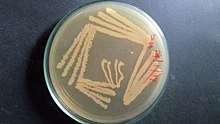Kytococcus sedentarius
Kytococcus sedentarius is a marine dwelling Gram positive bacterium in the genus Kytococcus. It is known for the production of polyketide antibiotics as well as for its role as an opportunistic pathogen. It is strictly aerobic and can only grow when amino acids are provided.
| Kytococcus sedentarius | |
|---|---|
 | |
| Kytococcus sedentarius culture on Zobell's Marine Agar (Himedia) plate (quadrant streak plate). | |
| Scientific classification | |
| Domain: | |
| Phylum: | |
| Order: | |
| Family: | |
| Genus: | |
| Species: | K. sedentarius |
| Binomial name | |
| Kytococcus sedentarius (ZoBell and Upham 1944) Stackebrandt et al. 1995[1] | |
It is found in tetrads, irregular clusters, and cubical packets of eight. It is catalase positive, oxidase positive, and exhibits strictly aerobic metabolism. Optimum growth temperature is 25-37 C. It is primarily isolated from human skin, and is one of the major causes of pitted keratolysis.[2][3] Once considered a species of the genus Micrococcus.[4]
Genome
The genome has been sequenced and contains 2,785,024 bp,[5] which is among the smallest for Actinomycetes, with a G+C content of 71.6%. This encodes 2639 protein coding genes.
References
- Parte, A.C. "Kytococcus". LPSN.
- Longshaw, C. M.; Wright, J. D.; Farrell, A. M.; Holland, K. T. (2002). "Kytococcus sedentarius, the organism associated with pitted keratolysis, produces two keratin-degrading enzymes". Journal of Applied Microbiology. 93 (5): 810–816. doi:10.1046/j.1365-2672.2002.01742.x. ISSN 1364-5072. PMID 12392527.
- Makhecha, Meena; Dass, Shreya; Singh, Tishya; Gandhi, Riddhi; Yadav, Tulika; Rathod, Dipali (November 2017). "Pitted keratolysis - a study of various clinical manifestations". International Journal of Dermatology. 56 (11): 1154–1160. doi:10.1111/ijd.13744. ISSN 1365-4632. PMID 28924971.
- "Kytococcus sedentarius". www.vumicro.com. Retrieved 2016-07-08.
- Sims, David; Brettin, Thomas; Detter, John C.; Han, Cliff; Lapidus, Alla; Copeland, Alex; Del Rio, Tijana Glavina; Nolan, Matt; Chen, Feng; Lucas, Susan; Tice, Hope; Cheng, Jan-Fang; Bruce, David; Goodwin, Lynne; Pitluck, Sam; Ovchin-Nikova, Galina; Pati, Amrita; Ivanova, Natalia; Mavrommatis, Konstantinos; Chen, Amy; Palaniappan, Krishna; d'Haeseleer, Patrik; Chain, Patrick; Bristow, Jim; Eisen, Jonathan A.; Markowitz, Victor; Hugenholtz, Philip; Schneider, Susanne; Göker, Markus; et al. (2009). "Complete genome sequence of Kytococcus sedentarius type strain (541)". Stand Genomic Sci. 1 (1): 12–20. doi:10.4056/sigs.761. PMC 3035214. PMID 21304632.
Further reading
- Gao, Min; Wang, Ke; Su, Rongguo; Li, Xuzhao; Lu, Wei (Jul 2014). "Antifouling potential of bacteria isolated from a marine biofilm". Journal of Ocean University of China. 13 (5): 799–804. doi:10.1007/s11802-014-2469-9.
External links